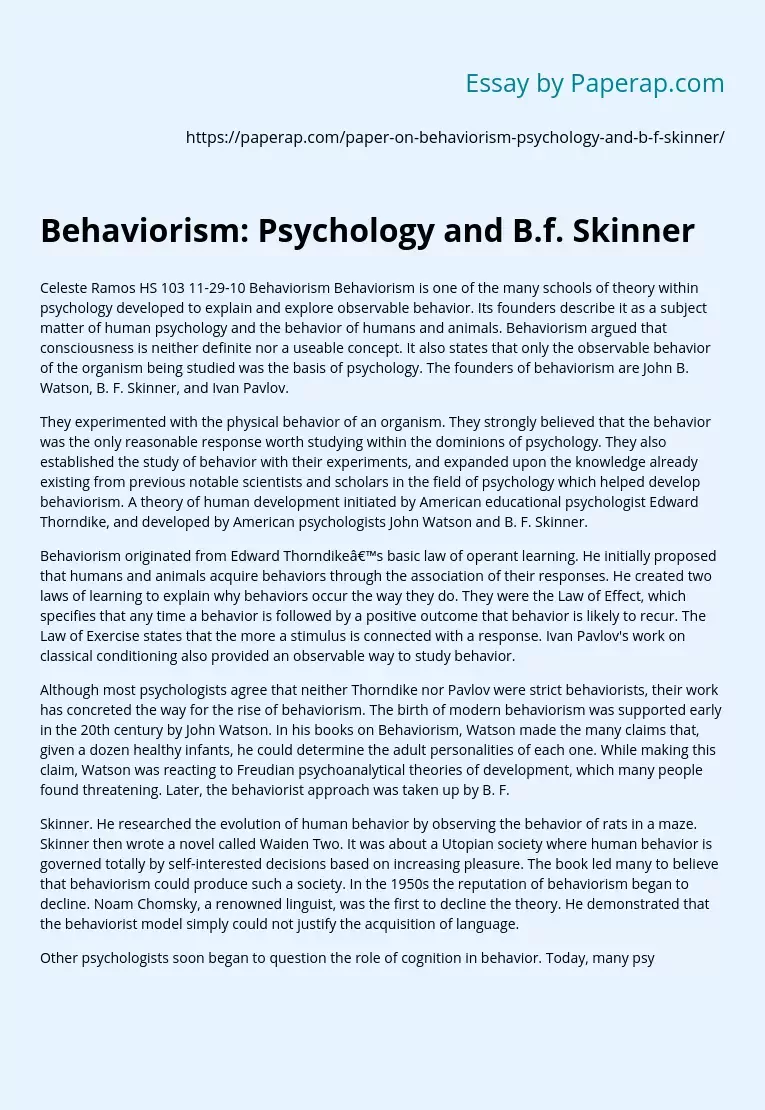Behaviorism: Psychology and B.f. Skinner
Celeste Ramos HS 103 11-29-10 Behaviorism Behaviorism is one of the many schools of theory within psychology developed to explain and explore observable behavior. Its founders describe it as a subject matter of human psychology and the behavior of humans and animals. Behaviorism argued that consciousness is neither definite nor a useable concept. It also states that only the observable behavior of the organism being studied was the basis of psychology. The founders of behaviorism are John B. Watson, B. F. Skinner, and Ivan Pavlov.
They experimented with the physical behavior of an organism. They strongly believed that the behavior was the only reasonable response worth studying within the dominions of psychology. They also established the study of behavior with their experiments, and expanded upon the knowledge already existing from previous notable scientists and scholars in the field of psychology which helped develop behaviorism. A theory of human development initiated by American educational psychologist Edward Thorndike, and developed by American psychologists John Watson and B.
F. Skinner.
Behaviorism originated from Edward Thorndike’s basic law of operant learning. He initially proposed that humans and animals acquire behaviors through the association of their responses. He created two laws of learning to explain why behaviors occur the way they do. They were the Law of Effect, which specifies that any time a behavior is followed by a positive outcome that behavior is likely to recur. The Law of Exercise states that the more a stimulus is connected with a response. Ivan Pavlov’s work on classical conditioning also provided an observable way to study behavior.
Although most psychologists agree that neither Thorndike nor Pavlov were strict behaviorists, their work has concreted the way for the rise of behaviorism. The birth of modern behaviorism was supported early in the 20th century by John Watson. In his books on Behaviorism, Watson made the many claims that, given a dozen healthy infants, he could determine the adult personalities of each one. While making this claim, Watson was reacting to Freudian psychoanalytical theories of development, which many people found threatening. Later, the behaviorist approach was taken up by B. F.
Skinner. He researched the evolution of human behavior by observing the behavior of rats in a maze. Skinner then wrote a novel called Waiden Two. It was about a Utopian society where human behavior is governed totally by self-interested decisions based on increasing pleasure. The book led many to believe that behaviorism could produce such a society. In the 1950s the reputation of behaviorism began to decline. Noam Chomsky, a renowned linguist, was the first to decline the theory. He demonstrated that the behaviorist model simply could not justify the acquisition of language.
Other psychologists soon began to question the role of cognition in behavior. Today, many psychologists debate the degree to which cognitive learning and behavioral learning affect the development of personality. There are many different types of behavior therapy techniques. Experiments by behaviorists identify conditioning as a universal learning process. There are two different types of conditioning. They each describe a different behavioral pattern. Classic conditioning occurs when a natural reflex responds to a stimulus.
One of the more common examples of classical conditioning in the educational environment is in situations where students exhibit irrational fears and anxieties like fear of failure, fear of public speaking. Alfred Bandura focused on the modification of personality traits in children and their social learning or modeling. common knowledge tell us that children learn by imitating others, but it was Bandura who is the most responsible for building a solid foundation for the concept of learning through modeling, or imitation. Operant conditioning occurs when a response to a stimulus is reinforced.
During operant conditioning it is used as feedback system. If a reward or reinforcement follows the response to a stimulus, then the response becomes more probable in the future. For example, B. F. Skinner used reinforcement techniques to teach pigeons to dance and bowl a ball in a mini-alley. The different techniques used to demonstrate operant conditioning are positive and negative reinforcement and punishment. Behaviorism is used on many different types of clients. It can be used on children and adults. Many adults that have anxiety issues, depression, and personality disorders use behavior therapy.
Many children with ADHD, autism and behavior problem use this type of therapy. Behavior therapy is useful to all ages, genders, and races. Behaviorism is very popular with the American culture but it has also been used in other parts of the world. In china, there was a study performed on an elderly Chinese woman. Asian beliefs compare mental illness with insanity. This only leads to denial of the existence of a problem but also creates barriers to help-seeking. There is a low rate of Chinese population at mental health facilities. This leads to incorrect assumptions that Chinese people do not experience mental health problems.
Research was revealed in 2003 and studies show that the rate for mental illness of Asian people in New Zealand was no different from that of European New Zealanders. Recent migrants experienced even higher levels of mental health problems. This caused high levels of post-traumatic stress symptoms. It also caused clinically diagnosable depressive symptoms, and greater levels of anxiety and emotional distress. Many of these psychological symptoms could be attributed to immigration and the process of adjustment into a foreign culture.
In the end, they concluded that CBT could be used as a conceptual framework in which to help the client develop an understanding of their problems. After doing a little more research on multicultural considerations, I found out that only 30 to 40% of conversations are verbal. Gestures, tones, posture, and eye contact can convey messages. Research stated that one should not stereotype of overgeneralize a client. Counselor should also be aware of individual differences, and that directness of conversation varies among cultures.
Behaviorism: Psychology and B.f. Skinner. (2018, Aug 10). Retrieved from https://paperap.com/paper-on-behaviorism-psychology-and-b-f-skinner/

